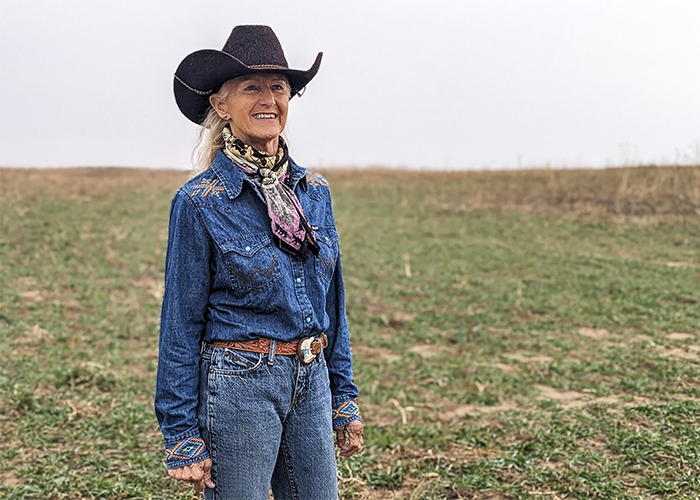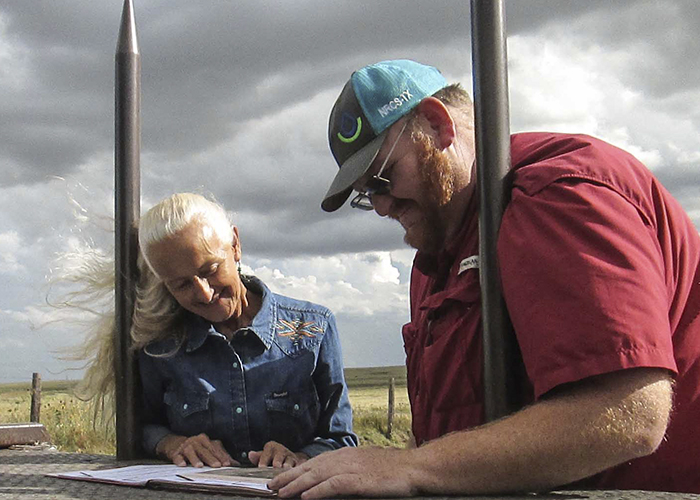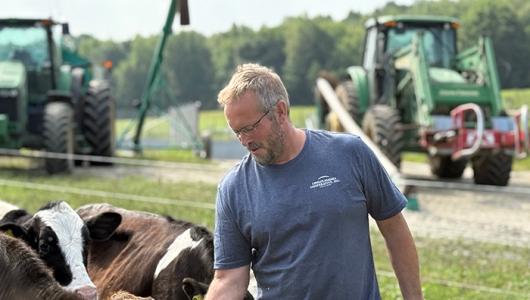Tammy Jo Nine Stotts is a fifth-generation rancher, operating in the northern Texas Panhandle and western Oklahoma. She and her husband, Leroy, also a fifth-generation rancher, are stewards of the land and livestock as their families were before them. They have two daughters together – one who has returned to the ranch to help carry on the ranching tradition.
In 2023, Tammy Jo was approved for funding through the Environmental Quality Incentive Program (EQIP) to return more of her cropland to native grass, including practices such as range planting, cover crop and prescribed grazing. These practices can help increase carbon stored in biomass and soils.
This was made possible through funding from the Inflation Reduction Act, which provides an additional $19.5 billion for USDA’s Natural Resources Conservation Service (NRCS) to deliver financial and technical assistance to producers for some conservation activities through existing USDA conservation programs like EQIP.
The Stotts’ operation consists mostly of commercial cow-calf herds on native grasslands. When it fits, they run stocker cattle (a class of cattle that graze on pasture to add weight inexpensively) on leased wheat pasture. “We like running cattle. Always have,” said Tammy Jo. “That’s what we do, and that’s what we plan to do. It’s in our blood.”
Tammy Jo’s great grandfather homesteaded in the Texas Panhandle in Lipscomb County. To help make ends meet, he also operated a trading post out of a covered wagon as the area was being settled. Her family continued farming and ranching in the same area, generation after generation. “My dad loved land, and he loved cattle,” said Tammy Jo. “He raised us all like that.”

When Tammy Jo inherited part of her parents’ land, she had a plan for it. She knew she couldn’t continue to farm the cropland. Living a couple of hours away, she understood that she couldn’t raise a crop efficiently or economically. “We used to farm a lot, out of necessity,” said Tammy Jo. “But times have changed, and we just run cattle on grass now.”
In 2023, Tammy Jo decided that adding another native grassland pasture would make sense for her livestock operation. It would create more grazable acres in the rotational grazing system for her cattle.
Returning the cropland back to its natural state of native grass was her goal. She wasn’t sure how to get there, so she turned to her local NRCS office in Follett. But this wasn’t Tammy Jo’s first experience working with the NRCS or participating in EQIP. “I have worked with NRCS for years. My parents worked with NRCS,” said Tammy Jo.
Assisted by Bruce Pickens Jr., District Conservationist for the Follett field office, she applied for Inflation Reduction Act funding through EQIP. “I needed help financially and guidance on what to do and how to do it. So, I consulted Bruce on [the] type of seed and everything,” said Tammy Jo.

Tammy Jo applied for help with the cost of converting the cropland back to grass. She was delighted when she received the news that her application was approved. With the inflated prices of supplies, she knew she wouldn’t be able to complete this endeavor on her own.
This time, her experience working with NRCS was a bit different. Thanks to NRCS’s new “Act Now” process, her application and contract were approved in time to plant her cover crop prior to planting grass. NRCS has accelerated conservation program funding decisions through its “Act Now” process, which enables states to pre-approve applications when they meet or exceed a state’s pre-determined minimum ranking score. “Being able to get a jump start and not have to wait until the following year to start the grass planting process was great,” said Tammy Jo.
Thanks to some timely rains in the area, the wheat that was planted as the cover crop for the native grass planting was already making a showing. “God’s been good to us with this rain. Hopefully it continues for the grass planting,” said Tammy Jo.

Tammy Jo intends to plant the native grass seed mix in 2024. She is excited to be working towards establishing more native grass for her livestock. Her passion for ranching is encompassed by her love for her land and her cattle. “That’s what I love to do. Work cattle. Raise cattle. Buy cattle,” said Tammy Jo. “I tell my daughters, do what you love. It’s not a rich way of living, but you’ll be happy.”
Rebecca Gresham is an acting public affairs specialist for NRCS in Texas.


